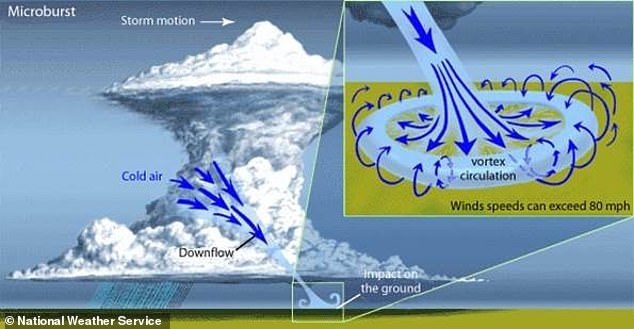
In a timelapse video, the storm cell, called a 'microburst,' is shown rolling across the sky, with its cylindrical plume of precipitation rising up and connecting with the clouds to form what some might have confused for a tornado.
According to the National Weather Service, microbursts happen when a thunderstorm begins to suspend water droplets and hail in its updraft.
Sometimes, if the updraft is strong enough, large amounts of precipitation get caught in the upper portion of the storm.
As the draft dissipates and the storm shifts, however, the droplets and hail are released, unleashing a deluge of rain and ice particles onto the ground.
In some cases, these types of storms can lead to extreme damage on the areas in which they fall.
On top of powerful precipitation, the storms can also unleash winds up to 100 mph which is why the National Weather Service says the storm should be taken as seriously as tornado warnings.
In the case of this particular storm caught by onlookers in Calgary, winds were reportedly mild in comparison to other storms of its kind, according to GlobalNews.
The hail produced by storms can also create significant problems, though according to Global News the hail produced by Calgary's microburst was mostly harmless aside from a few reports of 'quarter-sized' hail in some neighborhoods.
Microbursts are typically generated by the confluence of several weather conditions including strong winds and dry air mixing and high precipitable water.
They also often occur in hot and humid summer months.
Adding to their potential danger, the furious storms are often difficult to predict as they form quickly and can be very fleeting, often lasting between five and 10 minutes.
'Unfortunately, Severe Thunderstorm Warning lead times for microbursts can be very short, or there may be no warning at all,' says the National Weather Service.
The storms are reportedly somewhat common in Alberta, especially Calgary, which is among the cities that experience thunderstorms most frequently in Canada.



No charge gives boring rain, no precipitable water gives only lightning.